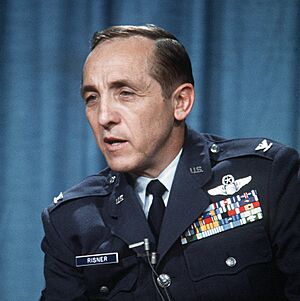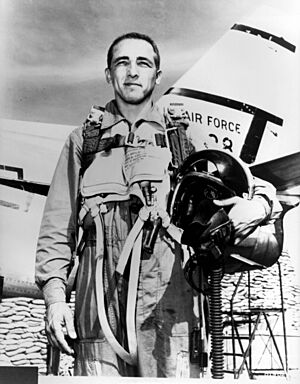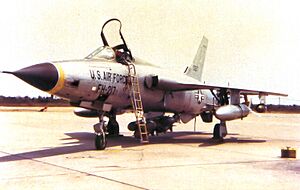James Robinson Risner facts for kids
Quick facts for kids
James Robinson Risner
|
|
|---|---|

Risner in 1973 after being released as a POW by the North Vietnamese
|
|
| Nickname(s) | Robbie |
| Born | January 16, 1925 Mammoth Spring, Arkansas, U.S. |
| Died | October 22, 2013 (aged 88) Bridgewater, Virginia, U.S. |
| Buried | |
| Allegiance | United States |
| Service/ |
United States Army Air Forces United States Air Force |
| Years of service | 1943–1946 1951–1976 |
| Rank | Brigadier General |
| Commands held | 832d Air Division 67th Tactical Fighter Squadron 34th Fighter-Day Squadron 81st Fighter-Bomber Squadron |
| Battles/wars | World War II Korean War Vietnam War |
| Awards | Air Force Cross (2) Air Force Distinguished Service Medal Silver Star (2) Distinguished Flying Cross (3) Bronze Star (3) Purple Heart (4) Air Medal (8) |
Brigadier General James Robinson "Robbie" Risner (born January 16, 1925 – died October 22, 2013) was a brave fighter pilot in the United States Air Force. He was also an important leader for American prisoners of war during the Vietnam War.
During the Vietnam War, Risner received the Air Force Cross twice. This is the second highest award for bravery in the U.S. Air Force. He earned the first for his courage in air battles. He received the second for his bravery as a prisoner of war for over seven years. He was the first living person to receive this medal.
Risner became a "flying ace" in the Korean War. This means he shot down five or more enemy aircraft. He led a group of F-105 Thunderchief jets in the first missions of Operation Rolling Thunder in 1965. He flew 163 combat missions in total. He was shot down twice and was credited with destroying eight MiG-15 planes. Risner retired from the Air Force in 1976 as a brigadier general.
After Risner passed away, General Mark A. Welsh III, the Air Force Chief of Staff, said: "Brig. Gen. James Robinson 'Robbie' Risner was part of that legendary group who served in three wars, built an Air Force, and gave us an enduring example of courage and mission success... Today's Airmen know we stand on the shoulders of giants. One of 'em is 9 feet tall... and headed west in full afterburner."
Contents
Early Life and Interests
Risner was born in Mammoth Spring, Arkansas, in 1925. His family moved to Tulsa, Oklahoma, in 1931. His father worked as a sharecropper and then as a day laborer during the Great Depression. Later, his father sold used cars. Risner worked many part-time jobs as a young person to help his family. He delivered newspapers, ran errands, and worked at a drug store. He also worked as a welder and polished cars for his father.
Risner grew up in a religious family. He was a member of the 1st Assembly of God Church. He also wrestled for Tulsa Central High School. He graduated in 1942. Besides sports, Risner loved riding horses and motorcycles.
Military Career Highlights
Joining the Army Air Forces
Risner joined the United States Army Air Forces in April 1943. He trained to be a pilot at Williams Field, Arizona. In May 1944, he earned his pilot wings and became a 2nd Lieutenant. He then trained to fly P-40 Warhawk and P-39 Airacobra fighter planes. After that, he was sent to the 30th Fighter-Bomber Squadron in Panama.
His squadron was based at a basic airstrip in Aguadulce. Risner said he flew a lot there, but there wasn't much discipline on the ground. In January 1945, the squadron moved to Howard Air Force Base in the Panama Canal Zone. They began flying P-38 Lightning fighters. Their pilots were soon not allowed in the Officers Club because they were too rowdy.
In 1946, Risner had a motorcycle accident when he was not on duty. While he was in the hospital, he met Kathleen Shaw, a nurse. They got engaged and married the next month.
After leaving the military, Risner tried different jobs. He trained as a car mechanic, ran a gas station, and managed a garage. He also joined the Oklahoma Air National Guard. He flew P-51 Mustang planes almost every weekend. Once, he got lost in a hurricane while flying to Brownsville, Texas. He had to land in Mexico. He managed to fly his Mustang to Brownsville after the storm. He received a quiet warning for flying an armed fighter into another country's territory.
Korean War Service
Risner was called back to active duty in February 1951. He trained to fly the F-80 Shooting Star jet. Risner really wanted to go to combat. Just before going overseas, he broke his hand and wrist falling from a horse. He hid the injury so he wouldn't be grounded. He even took off his cast to fly his first mission.
Risner arrived in Korea on May 10, 1952. He was assigned to the 15th Reconnaissance Squadron. In June, he transferred to the 336th Fighter Squadron. Risner often flew an F-86 jet nicknamed Ohio Mike. It had a Bugs Bunny cartoon painted on its nose. He achieved most of his air victories in this plane.
On August 5, 1952, Risner's flight of four F-86 Sabres met 14 MiG-15s. In a quick dogfight, Risner shot down one MiG. This was his first aerial victory.
On September 15, Risner's flight protected F-84 Thunderjet bombers attacking a chemical plant. Risner chased one MiG at very high speed near the ground. He pursued it into China, about 35 miles (56 km) past the border. He hit the MiG many times and shot off its canopy. He chased it between hangars at the enemy airbase and shot it down.
On the way back, Risner's wingman, 1st Lt. Joseph Logan, was hit by anti-aircraft fire. Risner tried to push Logan's damaged plane by putting his own jet's nose into Logan's tailpipe. This was a very risky and untried move. Risner tried to push Logan's plane to an island where a rescue helicopter was waiting. Fuel and hydraulic fluid sprayed onto Risner's canopy, blocking his view. Turbulence also kept separating the two jets. Risner managed to guide the powerless plane over the sea. Near the island, Logan bailed out. Logan drowned because he got tangled in his parachute. Risner's own engine flamed out, but he managed to land his plane without power.
On September 21, he shot down his fifth MiG. This made him the 20th "jet ace." In October 1952, Risner was promoted to major. He became the operations officer for the 336th FIS. Risner flew 108 missions in Korea. He was credited with destroying eight MiG-15s. His last victory was on January 21, 1953.
Regular Air Force Career
After the Korean War, Risner joined the Regular Air Force. He was assigned to the 50th Fighter-Bomber Wing in New Mexico. He became operations officer of the 81st Fighter Squadron. He flew F-86s with the 50th Wing to open Hahn Air Base in West Germany. In November 1954, he became commander of the 81st FBS.
In July 1956, he moved to George Air Force Base, California. He became operations officer of the 413th Fighter Wing. Later, he commanded the 34th Fighter Squadron.
While at George Air Force Base, Risner was chosen for a special flight. He flew an F-100F Super Sabre called Spirit of St. Louis II from New York to Paris. He followed the same route as Charles A. Lindbergh. He set a new transatlantic speed record, flying the distance in 6 hours and 37 minutes.
From 1960 to 1961, he attended the Air War College. Then he worked for the Commander-in-Chief, Pacific (CINCPAC) in Hawaii.
Vietnam War Service
In August 1964, Lieutenant Colonel Risner took command of the 67th Fighter Squadron. This was an F-105D Thunderchief fighter-bomber unit. It was based at Kadena AB, Okinawa. In January, he led a group of seven aircraft to Da Nang Air Base for combat strikes. On January 13, they destroyed a bridge in Laos. Risner was later warned for losing an aircraft while bombing a second bridge that was not authorized.
On February 18, 1965, the 67th TFS began temporary duty in Thailand. This was part of Operation Rolling Thunder, ordered by President Lyndon B. Johnson. Risner's squadron led the first strike on March 2. They bombed an ammunition dump in North Vietnam. Risner's squadron was supposed to suppress anti-aircraft fire. His wingman, Capt. Robert V. "Boris" Baird, was shot down. Risner took charge and directed the search and rescue mission for Baird. Risner's own plane was damaged, but he managed to land it at Da Nang.
On March 22, 1965, Risner was leading F-105s to attack a radar site. He was hit by ground fire when he circled back over the target. He flew his plane over the Gulf of Tonkin. He ejected a mile offshore and was rescued after fifteen minutes in the water.
On April 3 and 4, 1965, Risner led two large missions against the Thanh Hóa Bridge in North Vietnam. On April 3, his plane was hit as a missile struck the bridge. He fought a serious fuel leak and a smoke-filled cockpit. He again managed to fly his damaged aircraft to Danang. The next day, 48 F-105s attacked the bridge again, but it was not destroyed. These missions saw the first time U.S. aircraft were intercepted by North Vietnamese MiG-17 fighters. Two F-105s were lost.
Risner's brave actions earned him the Air Force Cross. He was featured on the cover of Time magazine on April 23, 1965.
Shot Down and Captured
On September 16, 1965, Risner was on a mission to find and destroy surface-to-air missile (SAM) sites. He was flying very low and fast. His F-105 was hit by heavy ground fire. He tried to fly to the Gulf of Tonkin, but his plane caught fire and went out of control. He ejected and was captured by the North Vietnamese. This was his 55th combat mission.
Life as a Prisoner of War
Risner was first held at Hỏa Lò Prison, known as "The Hanoi Hilton." After two weeks, he was moved to "The Zoo" prison. There, his captors showed him his Time magazine cover. They told him his capture was very important to them. He was later sent back to Hỏa Lò Prison. This was punishment for sharing behavior rules with other prisoners. Risner was severely tortured for 32 days. He was forced to sign a confession for war crimes.
Risner spent over three years in solitary confinement. But he was an officer, so he felt responsible for keeping order. From 1965 to 1973, he helped lead American prisoners to resist their captors. They used secret messaging techniques, like "tap code." He inspired other prisoners with his faith and hope. Risner and Navy Commander James Stockdale helped the prisoners organize their resistance. Risner was a prisoner of war for seven years, four months, and 27 days. His five sons were ages 3 to 16 when he was shot down.
His story of being imprisoned became well-known after the war. His book, The Passing of the Night: My Seven Years as a Prisoner of the North Vietnamese, describes his torture and mistreatment. In his book, Risner said his faith in God and prayer helped him survive. He wrote about surviving a torture session in July 1967:
To make it, I prayed by the hour. It was automatic, almost subconscious. I did not ask God to take me out of it. I prayed he would give me strength to endure it. When it would get so bad that I did not think I could stand it, I would ask God to ease it and somehow I would make it. He kept me.
After Vietnam: Career and Family
Risner was promoted to colonel while he was a prisoner. He was part of the first group of prisoners released on February 12, 1973. This was called Operation Homecoming. In July 1973, he was assigned to the 1st Fighter Wing in Florida. He became ready for combat again in the F-4 Phantom II. In February 1974, Risner moved to Cannon Air Force Base. He commanded the 832d Air Division and flew the F-111 Aardvark fighter-bomber. He was promoted to brigadier general in May 1974. He retired from the Air Force on August 1, 1976.
Risner's family life had some sad times. His mother and brother died while he was a prisoner. His oldest son, Robbie Jr., died two years after his return. In June 1975, Risner divorced his first wife, Kathleen. In 1976, he married Dorothy Marie ("Dot") Williams. She was the widow of a fighter pilot who went missing-in-action in 1967. They stayed married until he died. Risner adopted her three youngest children. After retiring, he lived in Austin, Texas, and later in San Antonio. He worked with the D.A.R.E. program and raised quarter horses. He later moved to Bridgewater, Virginia.
Risner's Legacy and Honors
Risner is one of only four airmen to receive the Air Force Cross multiple times. This award is second only to the Medal of Honor.
The USAF Weapons School Robbie Risner Award was created in 1976. It was donated by H. Ross Perot to honor Risner and all Vietnam War prisoners of war. This award is given each year to the best graduate of the USAF Weapons School. The Risner Award is a large trophy of Risner in his flight suit. It is displayed at the United States Air Force Academy. A smaller copy is given to each winner.
A nine-foot bronze statue of Risner stands at the Air Force Academy. It was also commissioned by Perot and dedicated in 2001. The statue honors Risner and other prisoners who held religious services in prison. Risner once said, after his comrades sang "The Star-Spangled Banner" and "God Bless America", that "I felt like I was nine feet tall and could go bear hunting with a switch." The statue is nine feet tall in memory of this quote.
Perot also helped Risner become the Executive Director of the Texans' War on Drugs. President Ronald Reagan later appointed Risner as a U.S. Delegate to the United Nations General Assembly. He was also inducted into the Oklahoma Hall of Fame in 1974. In 2013, he was inducted into the Arkansas Military Veterans Hall of Fame.
In 2006, Risner appeared on the History Channel show Dogfights.
In 2012, the Air Force Academy began building its Center for Character and Leadership Development. The Perot Foundation gave $3.5 million to create the General James R. Risner Senior Military Scholar position at the center. This scholar will study military leadership and advise the Academy.
The chapter squadron of the Arnold Air Society for Southern California is named after Risner. He was inducted into the Arkansas Aviation Hall of Fame in 2015. On March 10, 2018, Risner was named the Class Exemplar for the United States Air Force Academy's Class of 2021.
Kadena Air Base has a fitness center named after Risner. This base is home to the 67th Fighter Squadron, which Risner once commanded.
Death and Burial
Risner died in his sleep on October 22, 2013, at his home in Bridgewater, Virginia. He had suffered a severe stroke three days earlier. Risner was buried at Arlington National Cemetery on January 23, 2014. H. Ross Perot and General Welsh spoke at his funeral. Many former prisoners of war and members of the 336th Fighter Squadron attended.
Awards and Decorations
General Risner received many awards and decorations for his service:
 |
||
| US Air Force Command Pilot Badge | ||
| Air Force Cross w/ 1 bronze oak leaf cluster |
||
| Air Force Distinguished Service Medal | Silver Star w/ 1 bronze oak leaf cluster |
Distinguished Flying Cross w/ Valor device and 2 bronze oak leaf clusters |
| Bronze Star w/ Valor device and 2 bronze oak leaf clusters |
Purple Heart w/ 3 bronze oak leaf clusters |
Meritorious Service Medal w/ 2 bronze oak leaf clusters |
| Air Medal w/ 1 silver and 2 bronze oak leaf clusters |
Joint Service Commendation Medal | Air Force Commendation Medal |
| Air Force Presidential Unit Citation | Air Force Outstanding Unit Award w/ Valor device and 2 bronze oak leaf clusters |
Prisoner of War Medal |
| American Campaign Medal | World War II Victory Medal | Army of Occupation Medal |
| National Defense Service Medal w/ 1 bronze service star |
Korean Service Medal w/ 2 bronze campaign stars |
Armed Forces Expeditionary Medal |
| Vietnam Service Medal w/ 3 silver and 1 bronze campaign stars |
Air Force Longevity Service Award w/ 1 silver and 2 bronze oak leaf clusters |
Armed Forces Reserve Medal |
| Small Arms Expert Marksmanship Ribbon | Republic of Korea Presidential Unit Citation | Republic of Vietnam Gallantry Cross |
| United Nations Service Medal for Korea | Vietnam Campaign Medal | Korean War Service Medal |




